A New Spatiotemporal Risk Index for Heavy Metals: Application in Cyprus
Abstract
:1. Introduction
- Account for soil erosion processes, thus linking heavy metal concentrations in soils with downstream potential sediment loads.
- Be dynamic (temporal), in terms of providing assessments in regular short time steps (and not simply static lumped values).
- Combine all required risk assessment components, i.e., threat, vulnerability, and impact.
- Be spatial in terms of providing standardized risk maps.
2. Index definition
- The Potential Ecological Risk Index (PERI, or Hakanson index) for the estimation of the risk associated with the concentration of heavy metals in soils or sediments [9].
- The G2 model for mapping risk of soil loss on a monthly-time scale [22].
- The Erosion Potential Model (EPM, or Gavrilovic) and specifically its sedimentation component, for estimating sediment delivery ratio (SDR) on a basin scale [23].
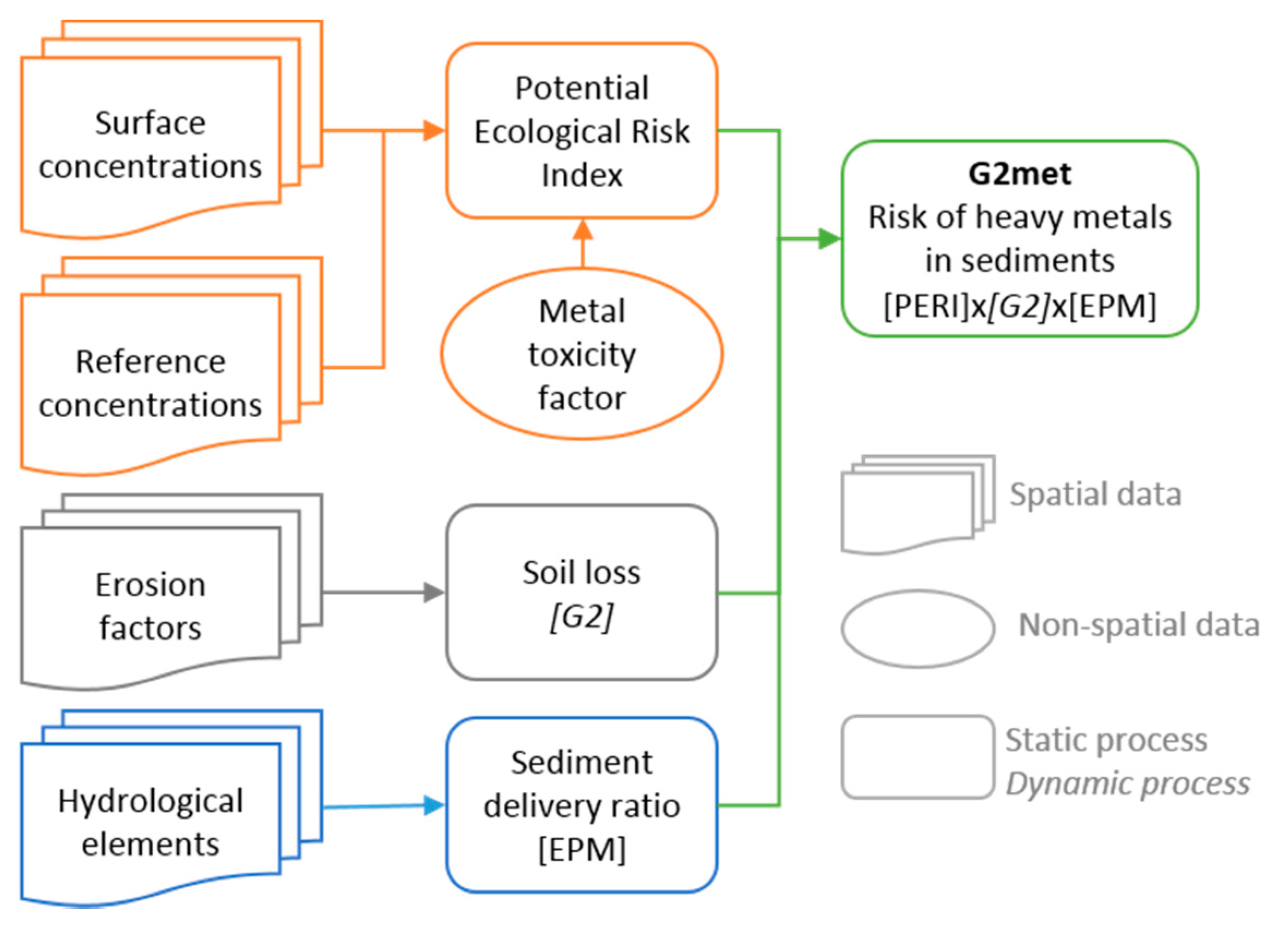
3. Application in Cyprus
3.1. Study Area
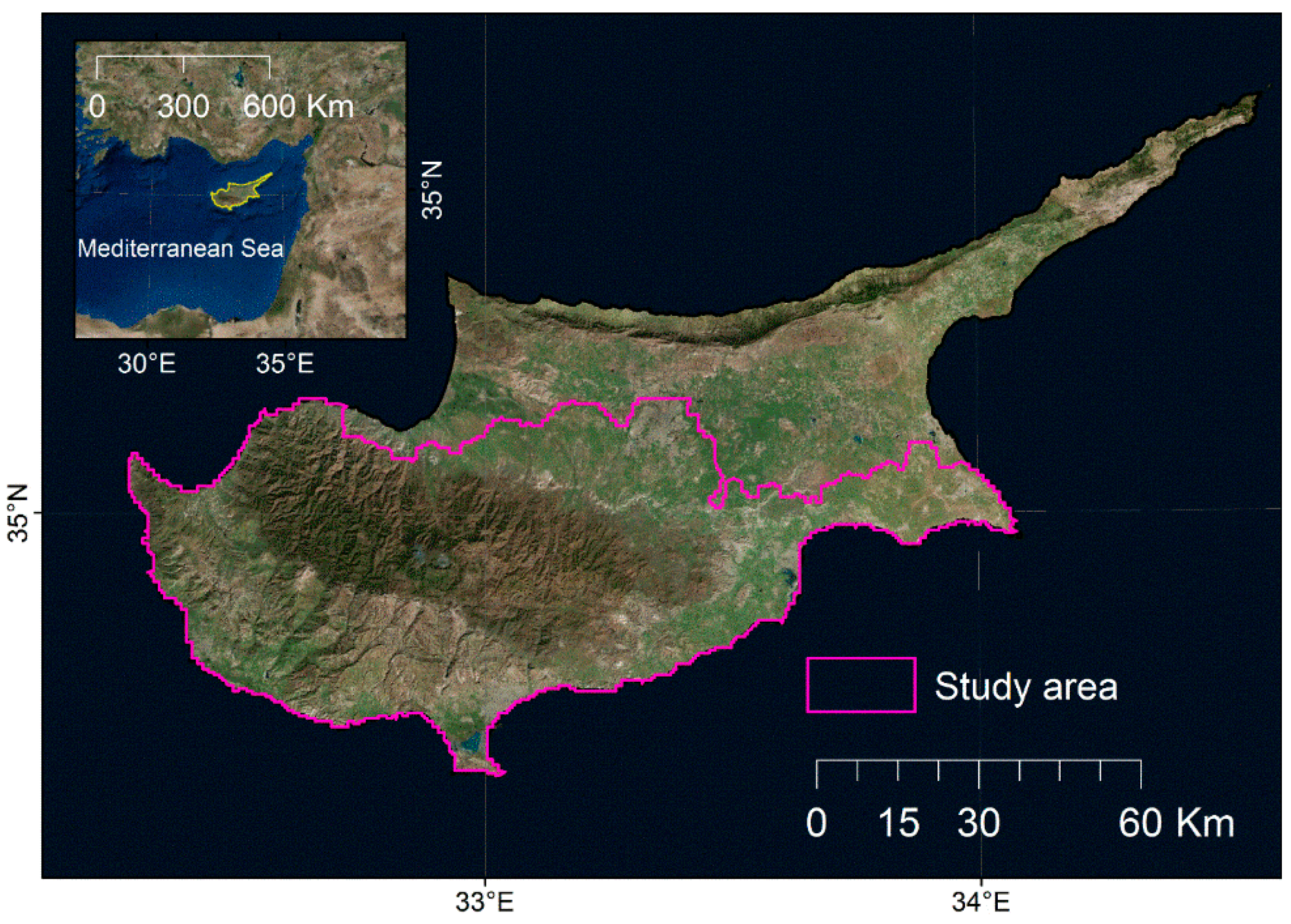
3.2. Calculation of the Hakanson Index
| Geologic Formation | Extent (%) | As | Cd | Cr | Ni | Pb | Zn | Hg | Cu |
|---|---|---|---|---|---|---|---|---|---|
| Pakhna | 15.4 | 5.6 | 0.4 | 57.8 | 62.5 | 12.7 | 44.0 | 0.034 | 39.7 |
| Alluvium or Colluvium | 9.1 | 5.0 | 0.2 | 60.3 | 55.4 | 7.4 | 50.6 | 0.035 | 57.1 |
| Fanglomerate | 6.0 | 5.7 | 0.2 | 55.6 | 44.4 | 8.4 | 53.1 | 0.025 | 43.5 |
| Nicosia | 6.5 | 7.0 | 0.2 | 50.4 | 42.1 | 9.6 | 56.0 | 0.031 | 43.6 |
| Lefkara | 10.3 | 3.0 | 0.3 | 36.8 | 47.0 | 6.4 | 39.1 | 0.032 | 51.8 |
| Basal Group | 6.4 | 3.2 | 0.2 | 53.8 | 42.1 | 4.2 | 109.8 | 0.035 | 167.5 |
| Sheeted Dykes (Diabase) | 18.0 | 1.6 | 0.1 | 51.2 | 38.1 | 2.5 | 68.8 | 0.030 | 195.7 |
| Average | – | 4.9 | 0.3 | 73.7 | 111 | 11 | 67 | 0.030 | 87.9 |
| Reference Sources | As | Cd | Cr | Ni | Pb | Zn | Hg | Cu |
|---|---|---|---|---|---|---|---|---|
| Weighted average Background values for Cypriot soils | 0.36 | 0.01 | 18.95 | 39.3 | 0.66 | 7.51 | 0.001 | 11.62 |
| Min weighted average Background for Cypriot soils | <0.1 | <0.1 | <5.0 | <0.1 | <0.1 | <0.1 | <0.01 | <0.1 |
| Μax weighted average Background for Cypriot soils | 3.42 | 0.12 | 161.7 | 420.1 | 9.88 | 81.5 | 0.012 | 229.6 |
| Threshold values for soils of pH > 7 | – | 1.5 | 100 | 70 | 100 | 200 | 1.0 | 100 |
| Reference values for Brazilian soils | – | <LQ | 47.9 | 8.7 | 15.3 | 22.4 | 18.2 |
3.3. Soil Loss Mapping Using the G2 model

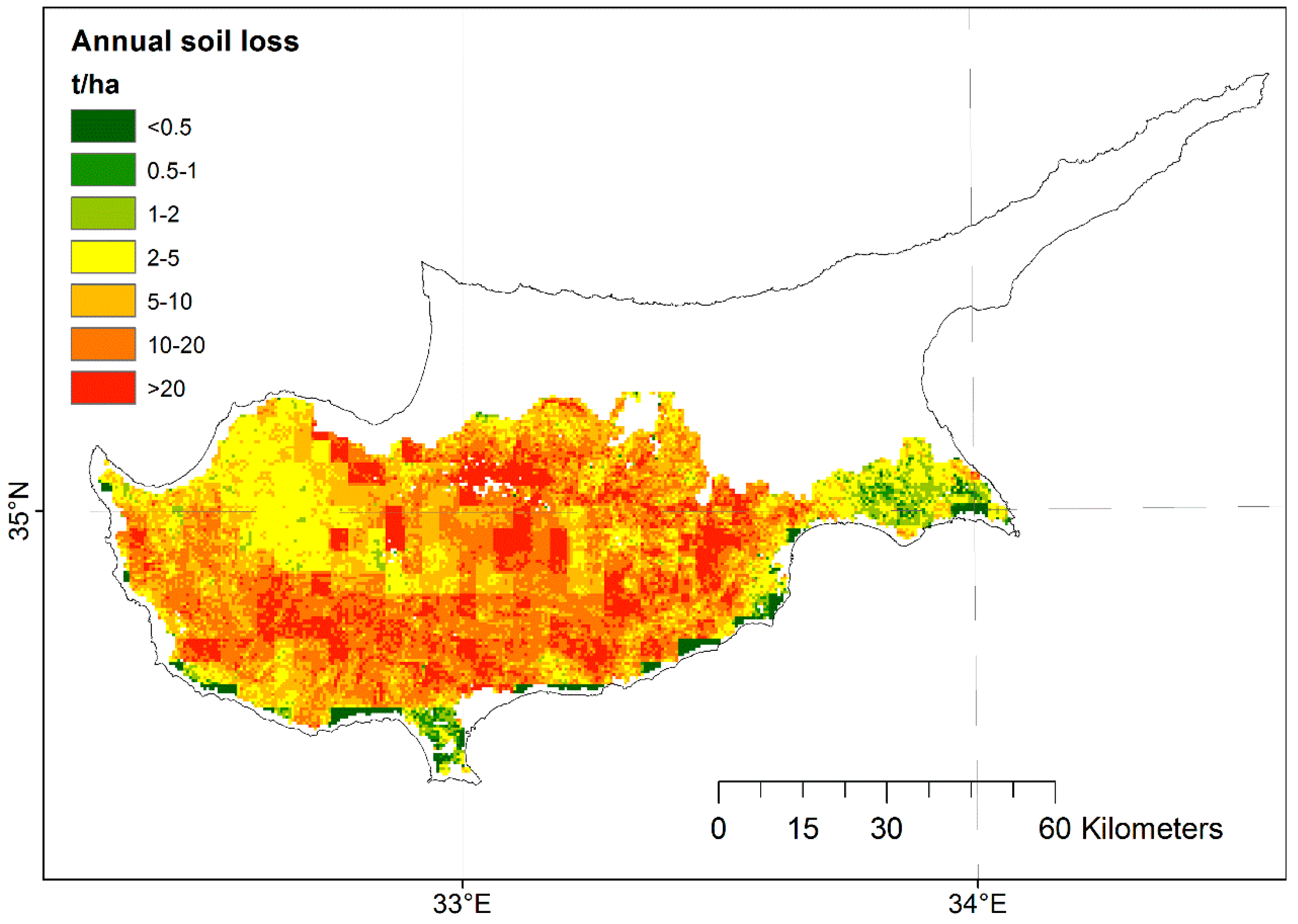
3.4. Sediment Delivery Ratio Using the EPM
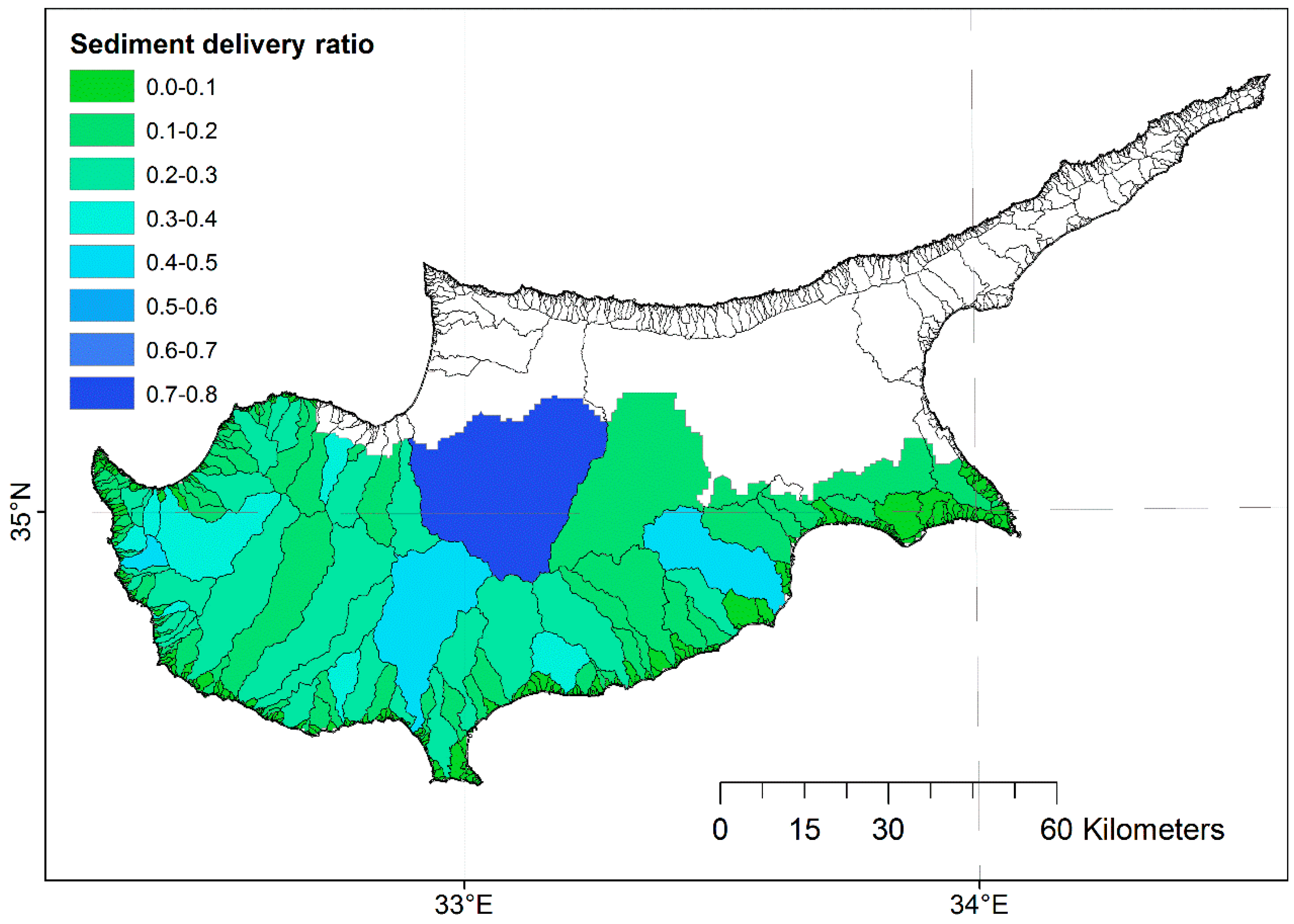
3.5. G2met Risk Maps and Statistics

| Month | Cd | Cr | Cu | Ni | Pb | Zn | Hg | As | Total |
|---|---|---|---|---|---|---|---|---|---|
| January | 3.437 | 0.228 | 0.610 | 0.632 | 0.920 | 0.130 | 3.873 | 0.873 | 10.707 |
| February | 1.751 | 0.103 | 0.256 | 0.284 | 0.498 | 0.058 | 1.622 | 0.397 | 4.971 |
| March | 1.012 | 0.055 | 0.143 | 0.150 | 0.283 | 0.032 | 0.853 | 0.220 | 2.752 |
| April | 0.962 | 0.048 | 0.134 | 0.142 | 0.230 | 0.027 | 0.792 | 0.212 | 2.549 |
| May | 3.852 | 0.289 | 0.880 | 0.885 | 0.760 | 0.142 | 4.778 | 1.094 | 12.657 |
| June | 3.526 | 0.239 | 0.730 | 0.747 | 0.769 | 0.126 | 4.739 | 0.917 | 11.796 |
| July | 4.306 | 0.318 | 0.989 | 1.008 | 0.864 | 0.158 | 7.839 | 1.156 | 16.641 |
| August | 1.740 | 0.112 | 0.405 | 0.423 | 0.374 | 0.068 | 3.206 | 0.425 | 6.730 |
| September | 2.846 | 0.217 | 0.529 | 0.589 | 0.723 | 0.115 | 3.234 | 0.802 | 9.058 |
| October | 7.607 | 0.622 | 1.700 | 1.774 | 1.780 | 0.316 | 10.700 | 2.207 | 26.709 |
| November | 8.027 | 0.617 | 1.708 | 1.762 | 1.830 | 0.323 | 10.426 | 2.250 | 26.947 |
| December | 6.342 | 0.404 | 1.069 | 1.101 | 1.619 | 0.229 | 6.568 | 1.634 | 18.968 |
| Annual (total) | 44.409 | 3.208 | 8.752 | 9.164 | 10.510 | 1.679 | 56.530 | 11.950 | 146.208 |
| Hakanson | 11.905 | 0.965 | 2.197 | 2.931 | 2.832 | 0.447 | 12.520 | 3.285 | 37.086 |
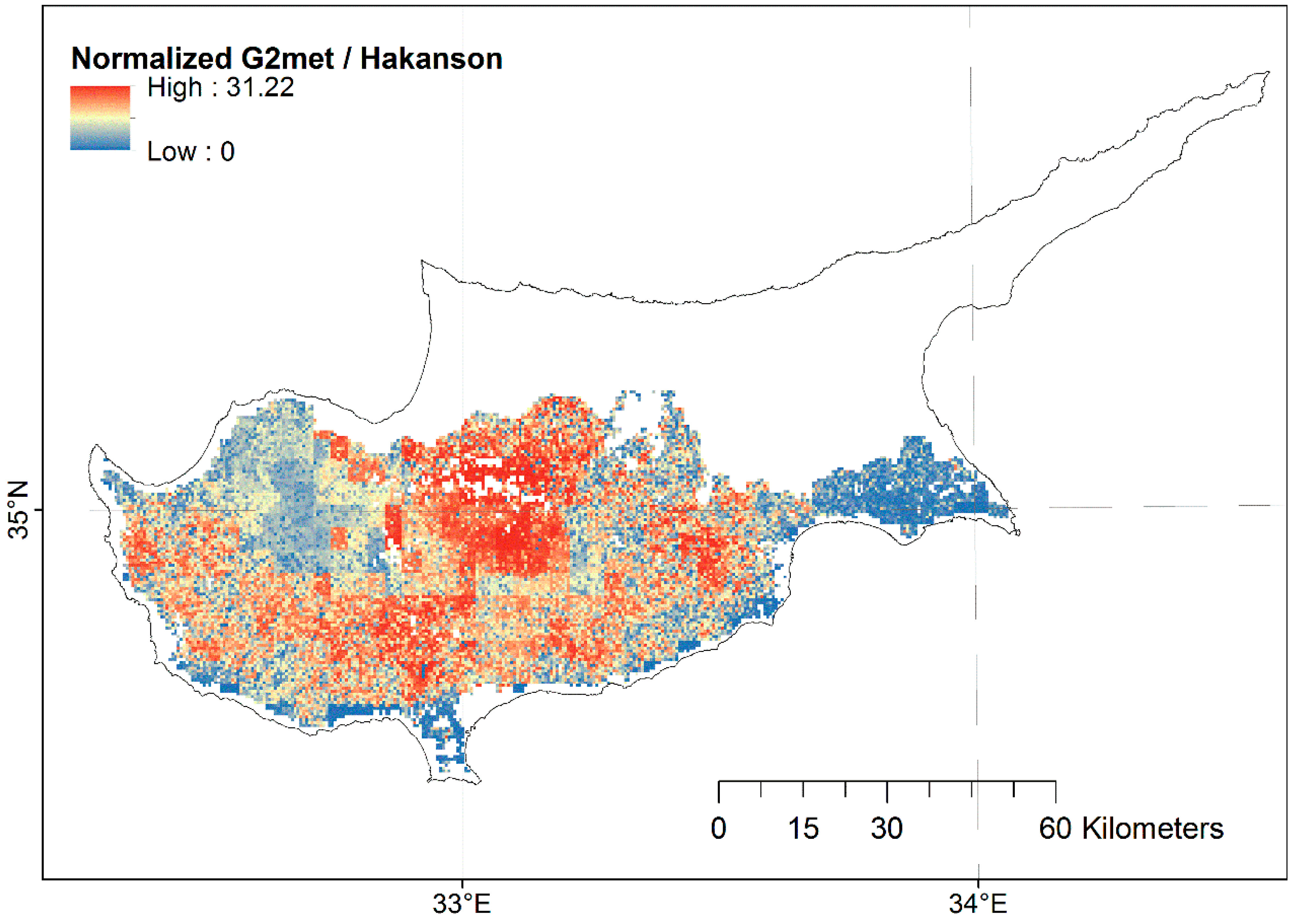



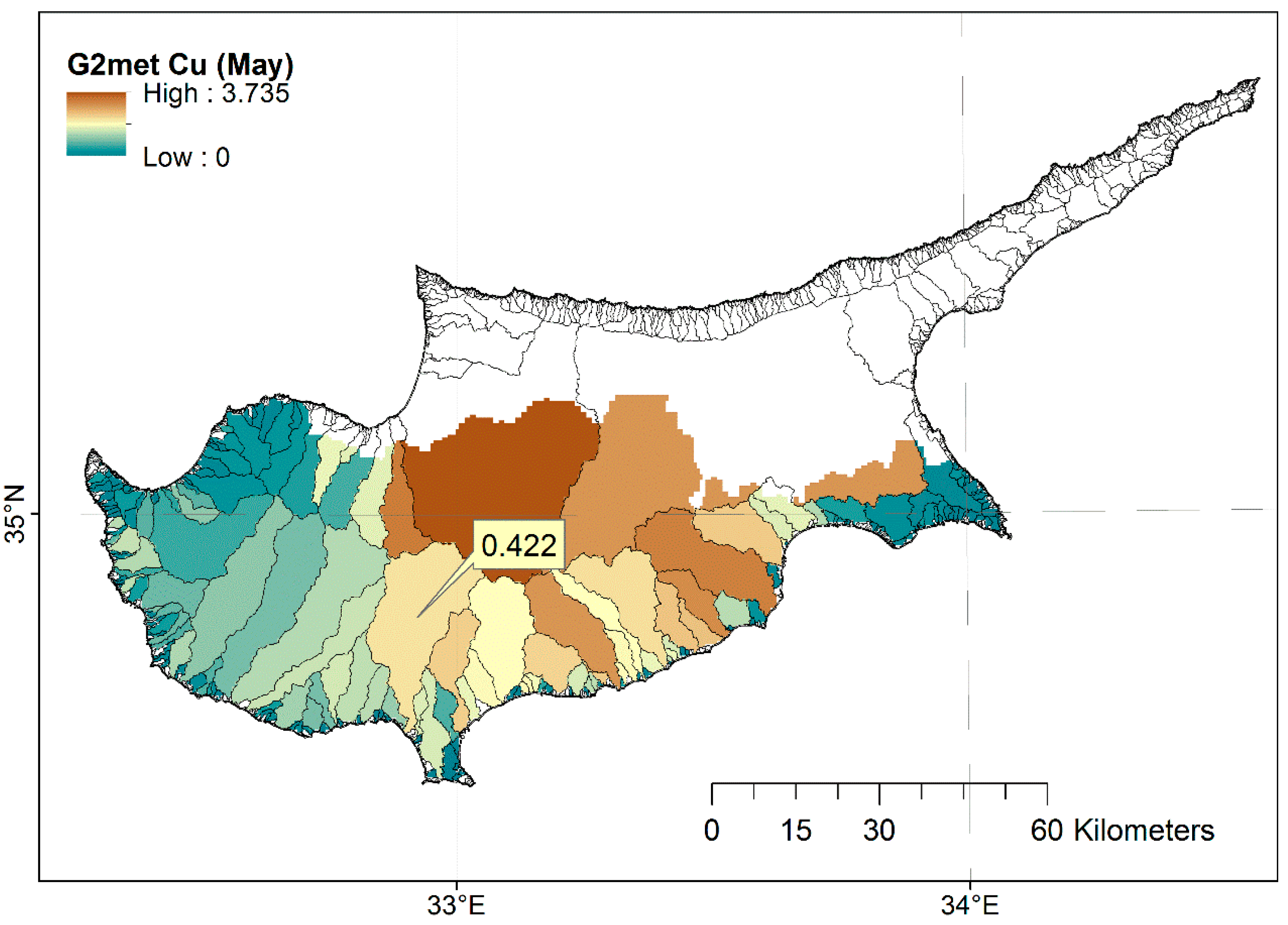
3.6. Evaluation Study
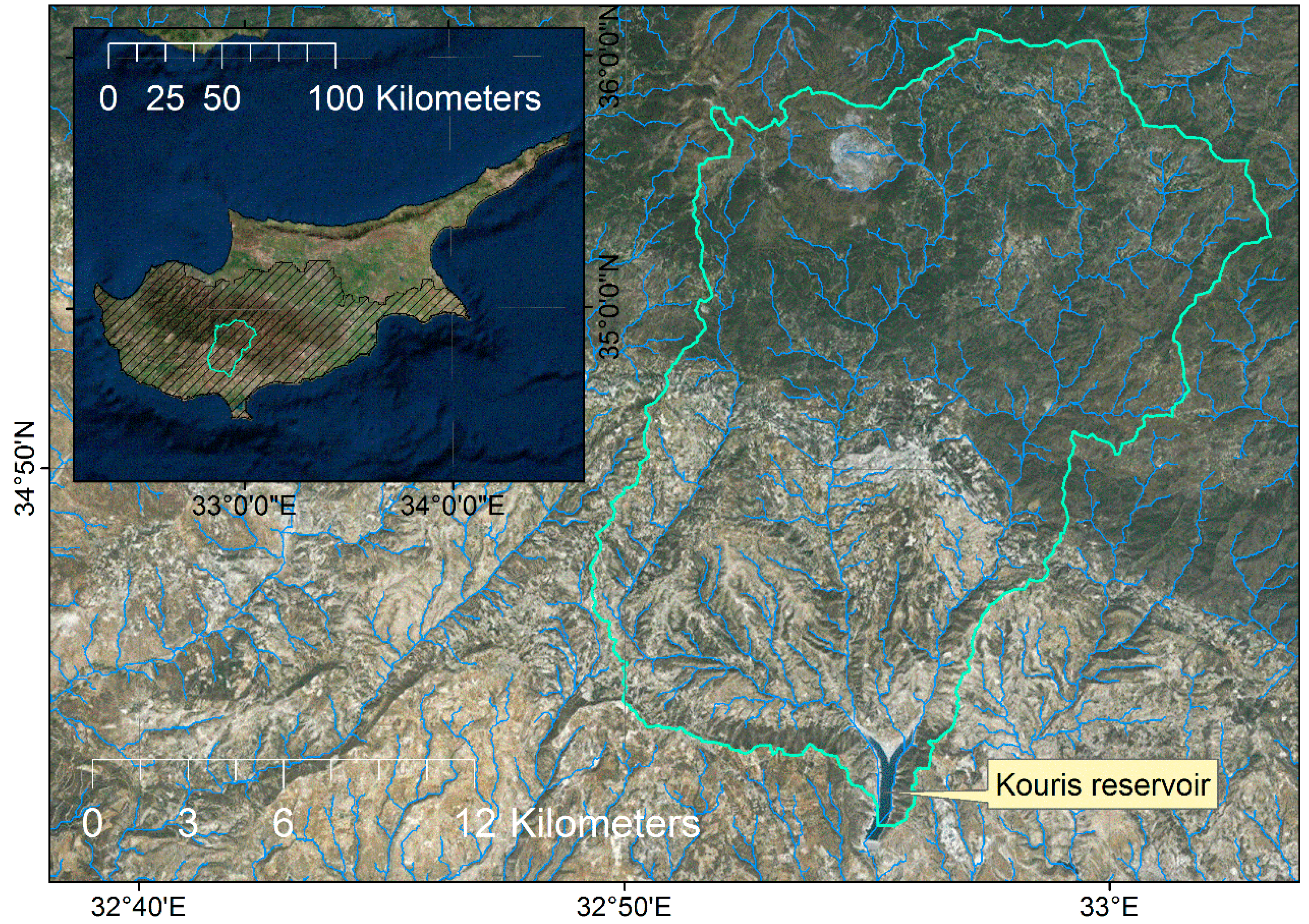
| Element Name | Sediments Samples (n = 4) May 2012 | Sediments Samples (n = 4) June 2014 | ||
|---|---|---|---|---|
| Mean | SD | Mean | SD | |
| Ni | 246.1 | 264.4 | 105.7 | 21 |
| Cr | 123.2 | 134.6 | – | – |
| Cu | 47.8 | 7.2 | 93.9 | 12.9 |
| Zn | 16.7 | 6.1 | 46.6 | 3.5 |
| As | <DL | – | – | – |
| Cd | <DL | – | 2.2 | 0.3 |
| Hg | <DL | – | <DL | – |
| Pb | 5.6 | 4.0 | 36.7 | 4.4 |
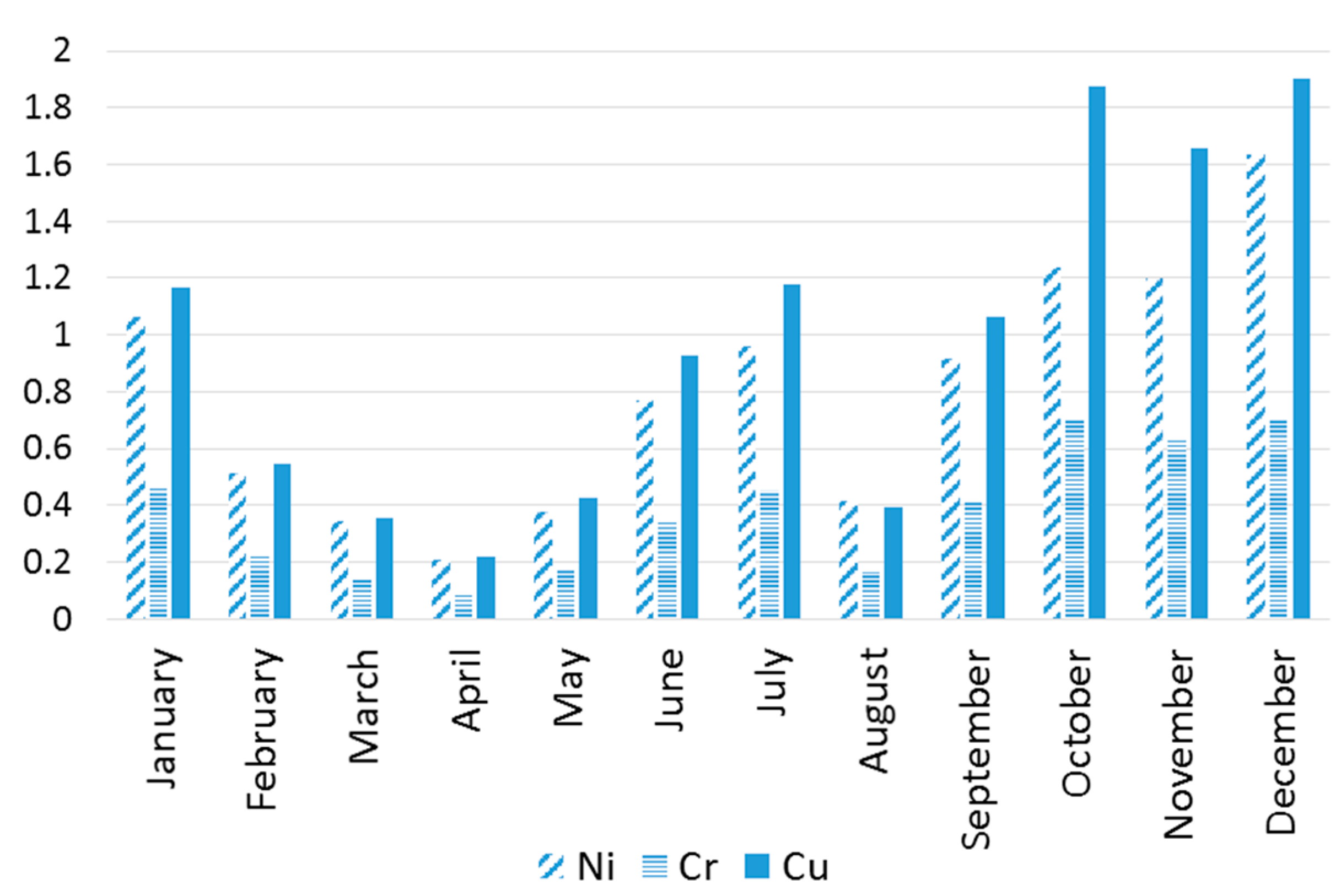
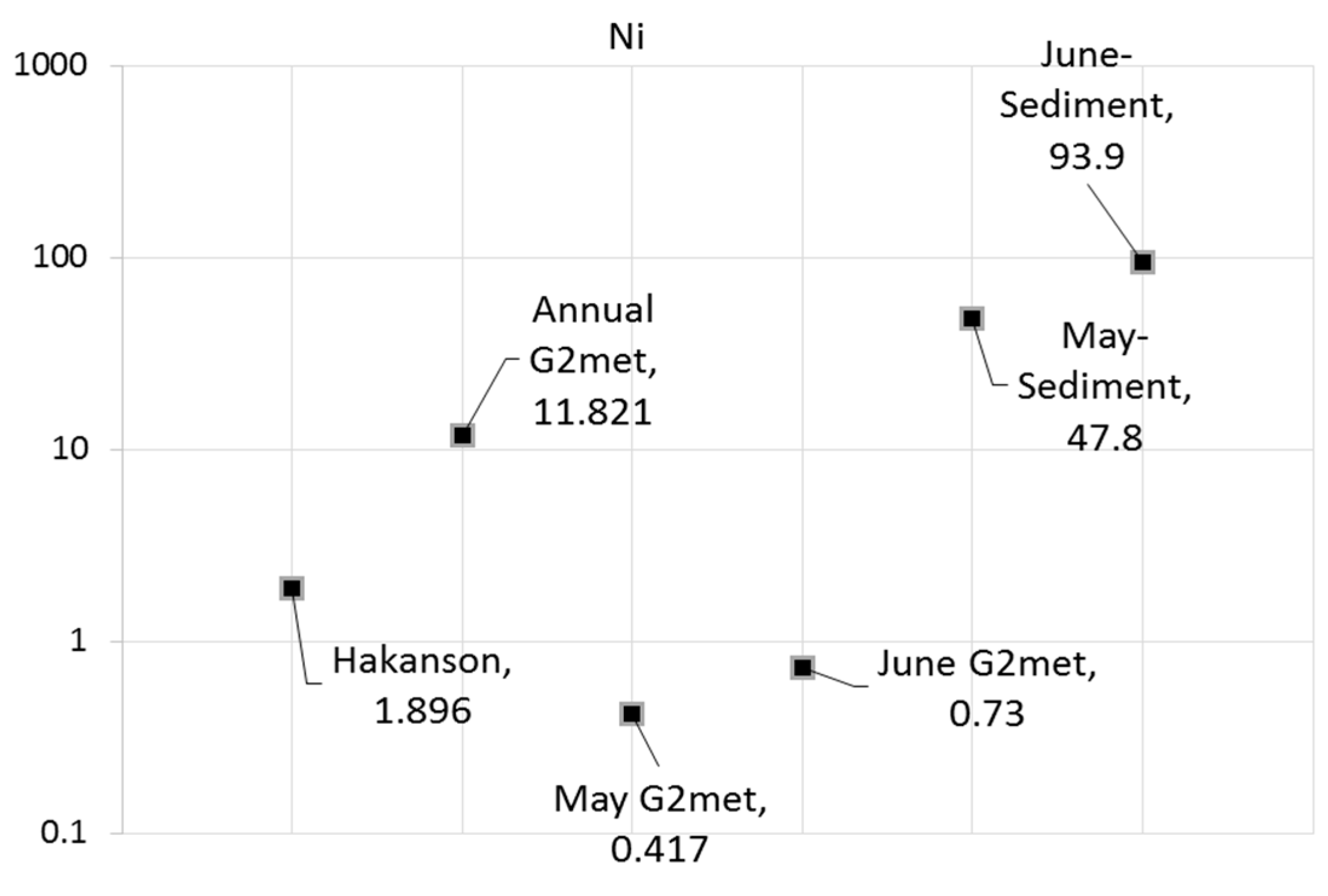
4. Conclusions and Outlook
Acknowledgments
Author Contributions
Conflicts of Interest
References
- Davies, O.A.; Abowei, J.F.N. Sediment quality of lower reaches of Okpoka Creek, Niger Delta, Nigeria. Eur. J. Sci. Res. 2009, 26, 437–442. [Google Scholar]
- Adeyemo, O.K.; Adedokun, O.A.; Yusuf, R.K.; Adeleye, E.A. Seasonal changes in physicao-chemical parameters and nutrient load of river sediment in Ibadan city, Nigeria. Glob. NEST J. 2008, 10, 326–336. [Google Scholar]
- Gong, Q.J.; Deng, J.; Xiang, Y.C. Calculating Pollution Indices by Heavy Metals in Ecological Geochemistry Assessment and a Case Study in Parks of Beijing. J. China Univ. Geosci. 2008, 19, 230–241. [Google Scholar]
- Müller, G. Index of geoaccumuation in sediments of the Rhine River. Geosci. J. 1969, 2, 108–118. [Google Scholar]
- Li, X.; Lee, S.; Wong, S.; Wong, S.C.; Shi, W.Z.; Thornton, I. The study of metal contamination in urban soils of Hongkong using a GIS-based approach. Environ. Pollut. 2004, 129, 113–124. [Google Scholar] [CrossRef] [PubMed]
- Nikolaidis, C.; Zafiriadis, I.; Mathioudakis, V.; Constantinidis, T. Heavy Metal Pollution Associated with an Abandoned Lead–Zinc Mine in the Kirki Region. Bull. Environ. Contam. Toxicol. 2010, 85, 307–312. [Google Scholar] [CrossRef] [PubMed]
- Wei, B.; Yang, L. A review of heavy metal contaminations in urban soils, urban road dusts and agricultural soils from China. Microchem. J. 2010, 94, 99–107. [Google Scholar] [CrossRef]
- Li, Z.Y.; Ma, Z.W.; van der Kuijp, T.J.; Yuan, Z.W.; Huang, L. A review of soil heavy metal pollution from mines in China: Pollution and health risk assessment. Sci. Total Environ. 2014, 468, 843–853. [Google Scholar] [CrossRef] [PubMed]
- Hakanson, L. An ecological risk index aquatic pollution control, a sedimentological approach. Water Res. 1980, 14, 975–1001. [Google Scholar] [CrossRef]
- Pradhan, B.; Lee, S.; Buchroithner, M.F. Use of geospatial data and fuzzy algebraic operators to landslide-hazard mapping. Appl. Geomat. 2009, 1, 3–15. [Google Scholar] [CrossRef]
- Brooks, N. Vulnerability, Risk and Adaptation: A Conceptual Framework. Available online: http://www.tyndall.ac.uk/sites/default/files/wp38.pdf (accessed on 30 May 2015).
- Pediaditi, K.; Stanojevic, M.M.; Kouskouna, C.G.; Karydas, D.; Ziannis, G.; Boretos, N. A decision support system for assessing and managing environment risk cross borders. Earth Sci. Inform. 2011, 4, 107–115. [Google Scholar]
- Pistocchi, R.; Pezzolesi, L.; Guerrini, F.; Vanucci, S.; Dell’aversano, C.; Fattorusso, E. A review on the effects of environmental conditions on growth and toxin production of Ostreopsis ovata. Toxicon 2011, 57, 421–428. [Google Scholar] [CrossRef] [PubMed]
- Lahr, J.; Kooistra, L. Environmental risk mapping of pollutants: State of the art and communication aspects. Sci. Total Environ. 2010, 408, 3899–3907. [Google Scholar] [CrossRef] [PubMed]
- Fraser, E.D.G.; Dougill, A.; Mabee, W.; Reed, M.S.; McAlpine, P. Bottom up and top down: Analysis of participatory processes for sustainability indicator identification as a pathway to community empowerment and sustainable environmental management. J. Environ. Manag. 2006, 78, 114–127. [Google Scholar] [CrossRef] [PubMed]
- Besio, M.; Ramella, A.; Bobbe, A.; Colombo, A.; Olivieri, C.; Persano, M. Risk maps: Theoretical concepts and techniques. J. Hazard. Mater. 1998, 61, 299–304. [Google Scholar] [CrossRef]
- Bartels, C.J.; van Beurden, A.U.C.J. Using geographic and cartographic principles for environmental assessment and risk mapping. J. Hazard. Mater. 1998, 61, 115–124. [Google Scholar] [CrossRef]
- Karydas, C.G.; Sarakiotis, I.L.; Zalidis, G.C. Multi-scale risk assessment of stream pollution by wastewater of olive oil mills in Kolymvari, Crete. Earth Sci. Inform. 2014, 7, 47–58. [Google Scholar] [CrossRef]
- Driesen, P.M. Erosion hazards and conservation needs as a function of land characteristics and land qualities. In Land Evaluation for Land-Use Planning and Conservation in Sloping Areas; ILRI: Wageningen, The Netherlands, 1986; pp. 32–39. [Google Scholar]
- Aksoy, H.; Kavvas, M.L. A review of hillslope and watershed scale erosion and sediment transport models. Catena 2005, 64, 247–271. [Google Scholar] [CrossRef]
- Olubunmi, F.E.; Olorunsola, O.E. Evaluation of the status of heavy metal pollution of sediment of agbabu bitumen deposit area, Nigeria. Eur. J. Sci. Res. 2010, 41, 373–382. [Google Scholar]
- Karydas, C.G.; Zdruli, P.; Koci, S.; Sallaku, F. Month-step erosion risk monitoring of Ishmi-Erzeni watershed, Albania using the G2 model. Environ. Model. Assess. 2015, 4, 1–16. [Google Scholar]
- Gavrilovic, Z. The use of empirical method (erosion potential method) for calculating sediment production and transportation in unstudied or torrential streams. In Proceeding of the International Conference on River Regime, Chichester, UK, 12 August 1988; pp. 411–422.
- US Environmental Protection Agency (EPA). Available online: http://water.epa.gov/polwaste/nps/whatis.cfm (accessed on 30 May 2015).
- Panagos, P.; Meusburger, K.; Ballabio, C.; Borrelli, P.; Alewell, C. Soil erodibility in Europe: A high-resolution dataset based on LUCAS. Sci. Total. Environ. 2014, 479, 189–200. [Google Scholar] [CrossRef] [PubMed] [Green Version]
- Westrich, B.; Kern, U. Mobility of Contaminants in the Sediments of Lock-Regulated Rivers-Field Experiments in the Lock Reservoir Lauffen, Modeling and Estimation of the Remobilisation Risk of Older Sediment Deposits; University of Stuttgart: Stuttgart, Germany, 1996. [Google Scholar]
- Dos Santos, S.N.; Alleoni, L.R. Reference values for heavy metals in soils of the Brazilian agricultural frontier in Southwestern Amazonia. Environ. Monit. Assess. 2013, 18, 5737–5748. [Google Scholar] [CrossRef] [PubMed]
- Cohen, D.R.; Rutherford, N.F.; Morisseau, E.; Zissimos, A.M. Geochemical patterns in the soils of Cyprus. Sci. Total Environ. 2012, 420, 250–262. [Google Scholar] [CrossRef] [PubMed]
- Westrich, B.; Forstrner, U. Sediment Dynamics and Pollutant Mobility in Rivers: An Interdisciplinary Approach; Springer: Berlin, Germany, 2007. [Google Scholar]
- Oliveira, S.M.B.; Pessenda, L.C.R.; Gouveia, S.E.M.; Favaro, D.I.T. Heavy metal concentrations in soils from a remote oceanic island, Fernando de Noronha, Brazil. An. Acad. Bras. Cienc. 2011, 83, 1193–1206. [Google Scholar] [CrossRef] [Green Version]
- Gawlik, B.M.; Bidoglio, G. Background Values in European Soils and Sewage Sludges, PART III Conclusions, Comments and Recommendations. Available online: http://eusoils.jrc.ec. europa.eu/ESDB_Archive/eusoils_docs/other/eur22265_3.pdf (accessed on 30 May 2015).
- Karydas, C.G.; Panagos, P.; Gitas, I.Z. A classification of water erosion models according to their geospatial characteristics. Int. J. Digit. Earth 2012, 7, 229–250. [Google Scholar] [CrossRef]
- Panagos, P.; van Liedekerke, M.; Jones, A.; Montanarella, L. European soil data centre: Response to European policy support and public data requirements. Land Use Polic. 2012, 29, 329–338. [Google Scholar] [CrossRef]
- Panagos, P.; Ballabio, C.; Borrelli, P.; Meusburger, K.; Klik, A.; Rousseva, S.; Tadić, M.P.; Michaelides, S.; Hrabalíková, M.; Olsen, P.; et al. Rainfall erosivity in Europe. Sci. Total Environ. 2015, 511, 801–814. [Google Scholar] [CrossRef] [PubMed]
- Meusburger, K.; Steel, A.; Panagos, P.; Montanarella, L.; Alewell, C. Spatial and temporal variability of rainfall erosivity factor for Switzerland. Hydrol. Earth Syst. Sci. 2012, 16, 167–177. [Google Scholar] [CrossRef] [Green Version]
- Hijmans, R.J.; Cameron, S.E.; Parra, J.L.; Jones, P.G.; Jarvis, A. Very high resolution interpolated climate surfaces for global land areas. Int. J. Clim. 2015, 25, 1965–1978. [Google Scholar] [CrossRef]
- Hastie, T.J.; Tibshirani, R.J. Generalized Additive Models; CRC Press: Boca Raton, FL, USA, 1990. [Google Scholar]
- VITO client ftp portal. Available online: catftp.vgt.vito.be (accessed on 30 May 2015).
- Verhoef, W. Earth observation modeling based on layer scattering matrices. Remote Sens. Environ. 1985, 17, 165–178. [Google Scholar] [CrossRef]
- Panagos, P.; Karydas, C.; Ballabio, C.; Gitas, I. Seasonal monitoring of soil erosion at regional scale: an application of the G2 model in Crete focusing on agricultural land uses. Int. J. Appl. Earth Obs. Geoinform. 2014, 27, 147–155. [Google Scholar] [CrossRef]
- Renard, K.G.; Foster, G.R.; Weessies, G.A.; McCool, D.K. Predicting Soil Erosion by Water: A Guide to Conservation plaNning with the REVISED Universal Soil Loss Equation (RUSLE); United States Department of Agriculture: Washington, DC, USA, 1997.
- Moore, I. D.; Burch, G.J. Physical basis of the lengthslope factor in the universal soil loss equation. Soil Sci. Soc. Am. J. 1986, 50, 1294–1298. [Google Scholar] [CrossRef]
- United States Geological Survey (USGS) portal. Available on line: http://earthexplorer.usgs.gov/ (accessed on 30 May 2015).
- Alexakis, D.D.; Hadjimitsis, D.G.; Agapiou, A. Integrated use of remote sensing, GIS and precipitation data for the assessment of soil erosion rate in the catchment area of “Yialias” in Cyprus. Atmos. Res. 2013, 131, 108–124. [Google Scholar] [CrossRef]
- O’Callaghan, J.F.; Mark, D.M. The extraction of drainage networks from digital elevation data. Comput. Vis. Graph. Image Process. 1984, 28, 328–344. [Google Scholar]
© 2015 by the authors; licensee MDPI, Basel, Switzerland. This article is an open access article distributed under the terms and conditions of the Creative Commons Attribution license (http://creativecommons.org/licenses/by/4.0/).
Share and Cite
Karydas, C.G.; Tzoraki, O.; Panagos, P. A New Spatiotemporal Risk Index for Heavy Metals: Application in Cyprus. Water 2015, 7, 4323-4342. https://doi.org/10.3390/w7084323
Karydas CG, Tzoraki O, Panagos P. A New Spatiotemporal Risk Index for Heavy Metals: Application in Cyprus. Water. 2015; 7(8):4323-4342. https://doi.org/10.3390/w7084323
Chicago/Turabian StyleKarydas, Christos G., Ourania Tzoraki, and Panos Panagos. 2015. "A New Spatiotemporal Risk Index for Heavy Metals: Application in Cyprus" Water 7, no. 8: 4323-4342. https://doi.org/10.3390/w7084323







